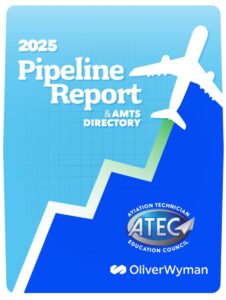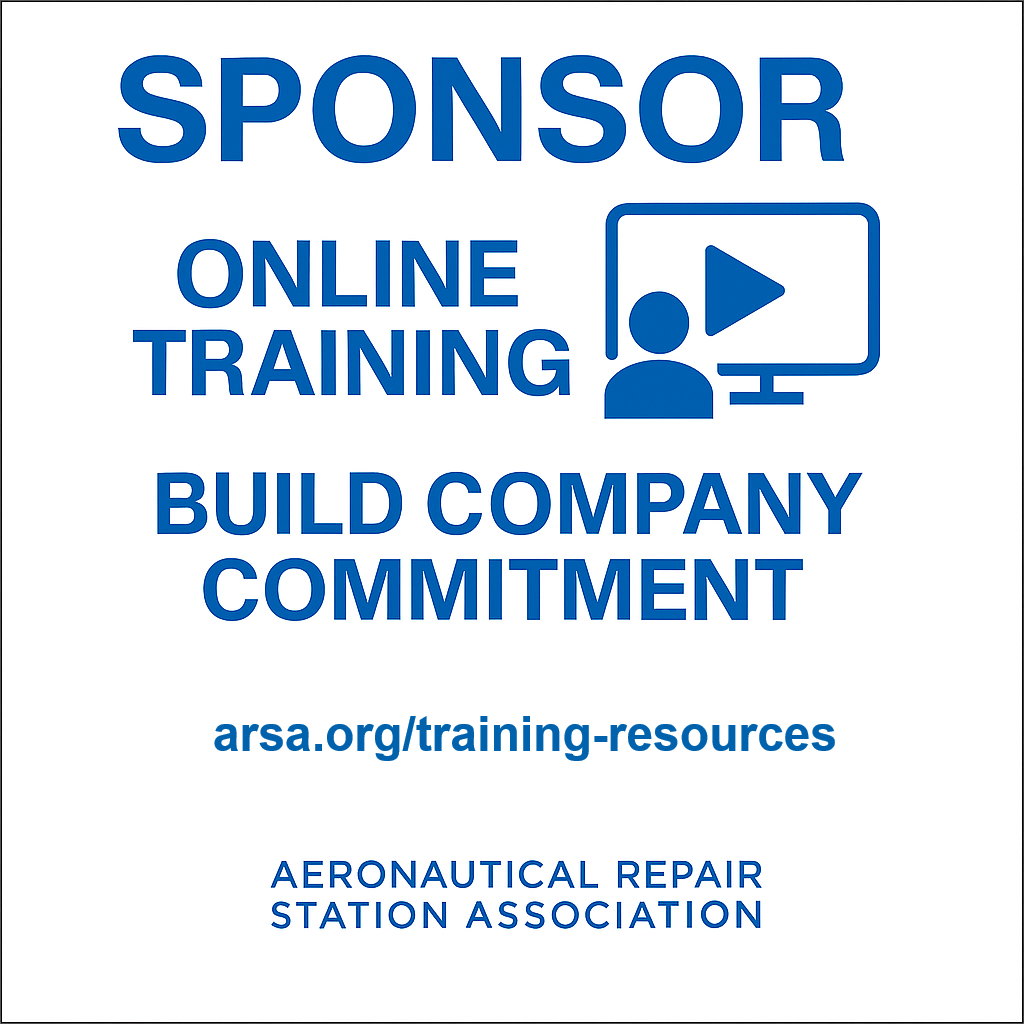U.S. Technician Pipeline Flowing Short of Demand
On Sept. 18, the Aviation Technician Education Council (ATEC) and Oliver Wyman Vector jointly released the 2025 Aviation Technician Pipeline Report. The report’s analysis found the U.S aviation maintenance industry posted its second-largest year-over-year increase in new mechanic certificates in 2024, bolstered by more output from FAA-certificated training schools. Despite the positive trend, the demand for new technicians to satisfy industry growth and retirements is still projected to outpace supply in the foreseeable future.
The U.S. civil commercial aviation maintenance workforce – including both certificated mechanics and non-certified technicians – includes more than 431,000 personnel. The Pipeline Report shows the FAA issued slightly more than 9,000 new mechanic certificates last year after a record-setting 9,401 in 2023. Aviation maintenance technician schools saw total graduates decrease just slightly from 2023’s highest-ever graduation cohort, which exceeded 10,000 students. Overall enrollment increased by 9 percent, though program vacancies resulting from students unwilling or unable to continue in school remain a problem.
Demand from commercial air transport alone is expected to drive a 10 percent shortage in certificated mechanics in 2025. This gap will narrow to seven percent by 2035, but will still represent a shortage of 10,000 certificated mechanics – before considering needs for non-certificated personnel. Additional demand from business and general aviation fleets further increases pressure on the technical workforce pipeline.
“We’re seeing some measurably positive trends at the grassroots level, building interest in pursuing aviation maintenance and the training needed to earn an FAA certificate,” said ATEC President and WSUTech Vice President Aviation & Workforce Development Jim Hall. “Near-term challenges will include bolstering these trends while ensuring that we have enough specialized personnel, notably instructors and examiners, to support it.”
Among the notable trends:
- Two-thirds of new mechanics obtained certification through an A&P school, with the remainder earning certification through military experience (14 percent) or work experience (20 percent).
- FAA figures show one-third of certificated mechanics were engaged in general aviation or working for repair stations, air carriers, or AMTS in 2024. Certificated mechanics represent 61 percent of the air operator maintenance workforce, 22 percent of the repair station workforce – and these maintenance facilities employ more non-certificated persons than the total number of individuals working at airlines – and 86 percent of the general aviation workforce.
- While AMTS enrollment rose 9 percent year-over-year, the A&P instructor workforce remained flat in 2024. This underscores the growing gap between teacher supply and demand and the challenges programs face in hiring and retaining certificated instructors.
- AMTS enrollment’s uptick is encouraging, but about one-third of available seats remain unfilled. The lack of awareness of aviation maintenance as a rewarding career path and instructor shortages are the leading contributors to below-capacity enrollment.
The Pipeline Report is produced annually by ATEC and Oliver Wyman to spotlight U.S. maintenance workforce trends. It is composed of insights from an annual survey, analysis by subject matter experts in both organizations, and data from the FAA and other publicly available sources.
To access the report, click here.
9/24/24 - Maintenance Educators Update Congress on Talent Pipeline
September 24, 2024
 On Sept. 19, the Aviation Technician Education Council (ATEC) released its 2024 Pipeline Report. The report’s analysis was performed by Oliver Wyman Vector, which also produces ARSA’s Annual Market Assessment, and presented during ATEC’s 2024 Washington Fly-In.
On Sept. 19, the Aviation Technician Education Council (ATEC) released its 2024 Pipeline Report. The report’s analysis was performed by Oliver Wyman Vector, which also produces ARSA’s Annual Market Assessment, and presented during ATEC’s 2024 Washington Fly-In.
The official release took place on Capitol Hill, as ATEC members representing part 147 schools, repair stations, and operators engaged the U.S. Congress on key mandates from this year’s reauthorization of the FAA. The report indicates new mechanic certificates jumped 32 percent in 2023, enrollment at aviation maintenance technician schools (AMTS) was up 6 percent, and 32 percent more American military veterans obtained FAA certification compared to 2022.
Despite the good news, the influx of new mechanics will be insufficient to meet commercial aviation’s projected needs amid rising demand for air travel for the next decade. The report estimates the current shortage to be 9 percent and projects it to reach nearly 20 percent – equivalent to about 25,000 certificated mechanics – by 2028. This continued shortfall reinforces ARSA’s broad interest in bolstering multiple pathways to maintenance careers, particularly in repair stations where the report indicated total employment includes non-certificated personnel filling the majority of technical roles.
As reported by ATEC, the report’s additional takeaways include:
- The surge in new certifications can be attributed to several factors, including an end (and apparent reversal) of deferrals, the development of new work-based certification pathway programs, a rise in student certifications in A&P programs, and increased enrollment.
- A lack of resources is constraining AMTS throughput. Many schools report maximum practical capacities that are below their allowable capacities due to shortages of instructors, facility space, or other resources. Designated Mechanic Examiner (DME) shortages are another key constraint. ATEC estimates that the industry needs 30% more DMEs just to account for the current flow of graduates.
- The percentage of women among newly certificated A&P mechanics is rising, but slowly. Women make up just 2.8 percent of the mechanic population, up from 2.2 percent a decade ago. Rates in the pipeline are slightly better: 6.7 percent of new AMTS-sourced certificated mechanics are women, compared to 4 percent of those sourced from military or civilian experience.
- The AMTS student load factor, which measures the ratio of available A&P program seats to enrolled students, has improved to 65 percent. Nationally, there are an estimated 12,000 seats available within the A&P school network. Despite commendable efforts and initiatives that boosted AMTS enrollments by 5% last year, one in every three available seats remains unfilled.
Before the official release, ARSA Vice President of Operations Brett Levanto joined the group on Sept. 18 for a day of briefings and discussion focused on how industry must push the agency to make good on provisions in the new law. Levanto, ATEC Executive Director Crystal Maguire, and Airlines for America Managing Director of Engineering & Maintenance, walked the group through the current status and next steps related to several key technician career development initiatives:
(1) Funding and program administration for technician workforce grants.
(2) Early testing for high school students completing aviation maintenance curriculua.
(3) Improved military to civilian career transitions.
(4) General expansion of technical education and funding opportunities.
Stay tuned to ARSA for updates on its pursuit of these programs and partnership with ATEC.
To download the pipeline report, click here to visit the ATEC website.
To review ARSA’s advocacy related to this year’s FAA reauthorization law, click here.









